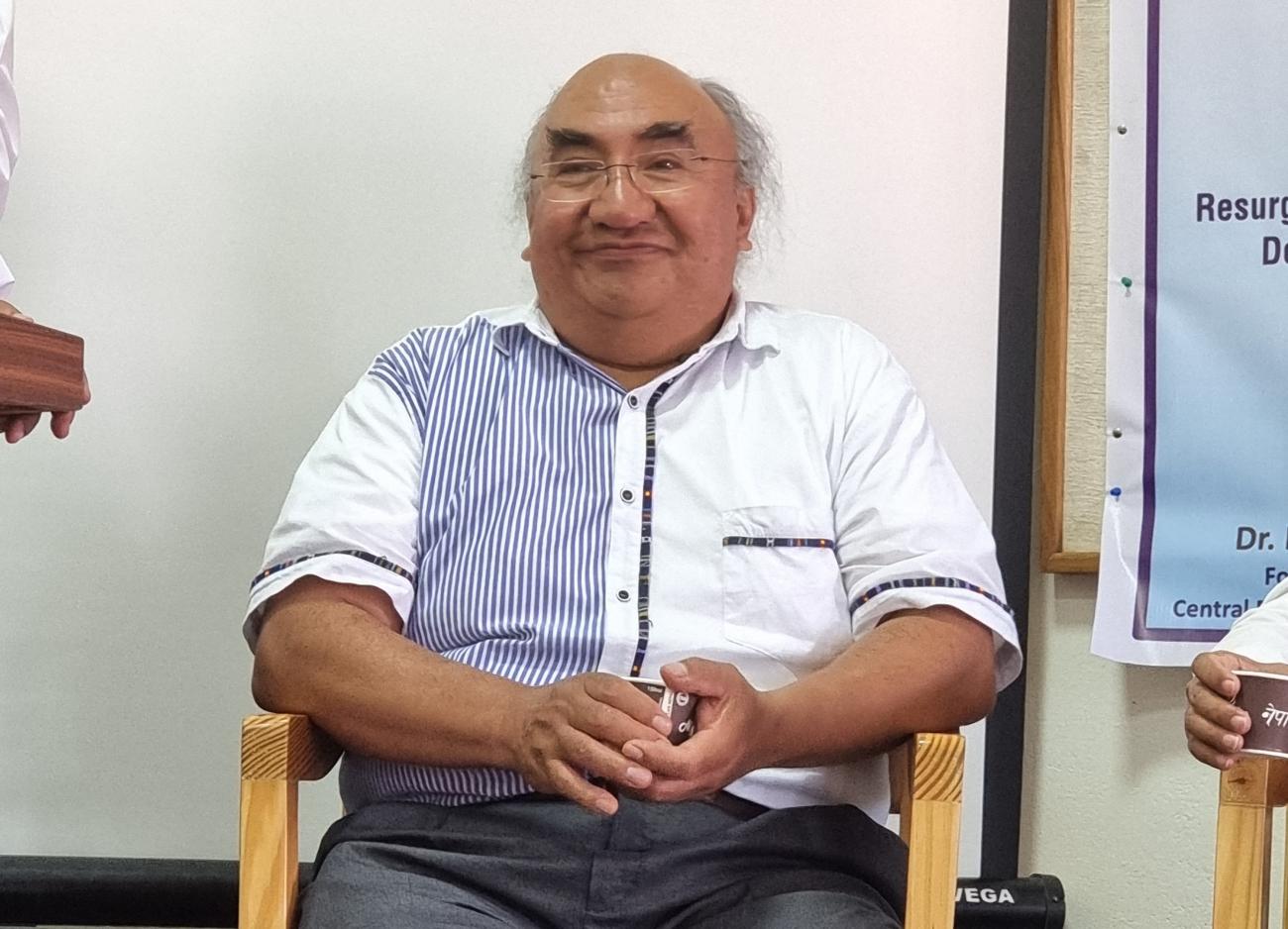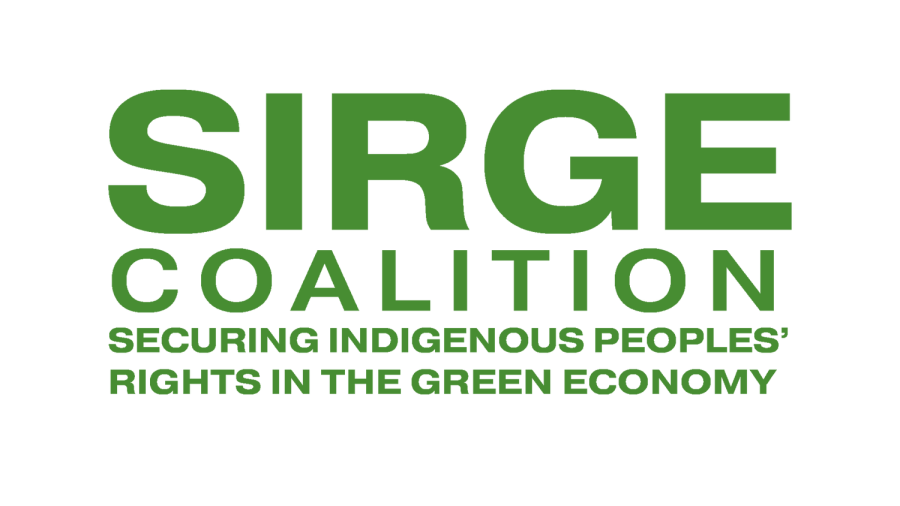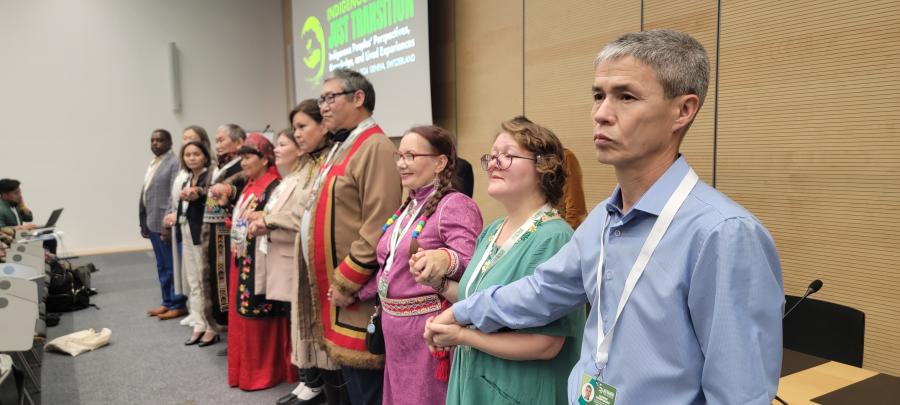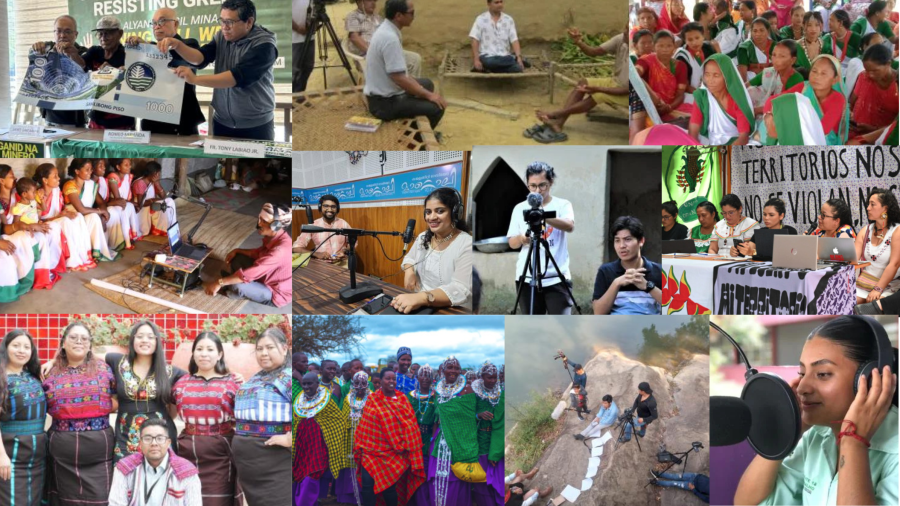
UN Special Rapporteur on the Rights of Indigenous Peoples, José Francisco Calí Tzay (Maya Kaqchikel), conducted a week-long visit to Nepal on September 10–17, 2023, to meet and learn more about Nepal’s Indigenous Peoples and the status of their human rights. Calí Tzay was invited to Nepal for academic purposes by the Central Department of Anthropology of Tribhuvan University, the oldest and biggest university in the country. During his visit, he conducted field visits to Birtamod, Dharan, and Terahthum, in eastern Nepal, where he met with Indigenous Peoples and learned about their struggles. Many Indigenous community members brought up the issue of land displacement, which they have suffered in the name of development, infrastructure, and conservation. Calí Tzay also had meetings with the representatives from the Nepal Federation of Indigenous Nationalities, the Youth Federation of Indigenous Nationalities, the Nepal Indigenous Women’s Federation, and the Nepal Indigenous Disabled Association, and he gave a lecture titled “International Human Rights Frameworks and Challenges Faced by Indigenous Peoples Globally.” A synopsis of the lecture was compiled below by Dev Kumar Sunuwar, Cultural Survival Staff, based in Kathmandu, Nepal.
At the international level, a comprehensive legal framework exists for effectively protecting Indigenous Peoples. They are protected by international human rights law due to their special status, and thus they enjoy a specific set of human rights. This special human rights system has been codified for Indigenous Peoples’ individual and collective rights and is established in several instruments. ILO Convention 169 and the UN Declaration on the Rights of Indigenous Peoples constitute the minimum standard for Indigenous Peoples' rights; states must respect and implement them. Nepal signed in favor of the adoption of the Declaration on September 13, 2007, and ratified ILO Convention 169 on September 14 of the same year.
Despite the existence of such international human rights standards, Indigenous Peoples continue to face challenges worldwide: firstly, the formal recognition of Indigenous Peoples’ rights in the domestic legal system; secondly, the development of megaprojects in their ancestral territories; thirdly, the impact of climate change adaptation measures in Indigenous territories; and fourthly, multiple forms of discrimination and violence against Indigenous women and girls.
Under international law, Indigenous Peoples have the right to self-determination, established in Article 1 in common with the United Nations International Covenant on Civil and Political Rights, the International Covenant on Economic, Social and Cultural Rights, and Article 3 of the Declaration. This means that Indigenous Peoples have the right to freely determine their political status and to freely pursue their economic, social, and cultural development. States don't like to recognize this right, as they are afraid that self-determination and Indigenous autonomy will lead to secession. But where there is unity and integrity, it cannot lead to the secession of the territory of an already established State. Therefore, I urge States to recognize the existence of Indigenous Peoples, which will generate national unity between diversity and create a space for plural, democratic articulation.
Without the right to self-determination, Indigenous Peoples cannot exercise their collective rights. Self-determination is fundamental to exercising the power of Indigenous Peoples to make decisions about priorities for development and control of their lives. A corollary of the right to self-determination is the right of Indigenous Peoples to political participation, which must be analyzed within the framework of the collective right of Indigenous Peoples to autonomy and self-government. However, many Indigenous Peoples worldwide are struggling to have their collective, as well as individual, rights recognized at the domestic level, particularly in the constitution. One of the main obstacles they face is a need for more consultation and participation during constitutional drafting.
Under international human rights law, Indigenous Peoples have the right to be consulted in good faith before adopting any legislation that affects them, as well as meaningful participation in political debates. It is also essential to recognize their right to autonomy and self-government. As provisioned in Article 4 of the Declaration, the right to autonomy includes the recognition of Indigenous Peoples’ institutions, which implies their right to maintain their own decision-making institutions, as well as their right to participate in the decision-making process of the State and other actors, particularly those affecting them. This must be carried out without external interference, meaning that the State has a duty not to interfere in the functioning of these institutions, and must provide financial and technical assistance. This obligation arises from Articles 4 and 39 of the Declaration.
Another important dimension of the right to participation is the effective possibility for Indigenous people to reach high-level positions in State institutions. When I was in Canada this year on an official visit, I was pleased to see that the Governor General of Canada is a woman and that most of the constitutional courts are led by Indigenous women. To achieve this kind of participation, some states have promoted positive actions such as quotas for Indigenous people in parliament or other state institutions. Of course, that is up to the State, but the participation of Indigenous people must be recognized in any decision.
Another aspect that I consider extremely important for implementing Indigenous Peoples’ right to meaningful participation is the recognition of Indigenous Peoples’ right to the justice system. Article 5 of the Declaration states that Indigenous Peoples have the right to maintain and strengthen their existing legal institutions. In this regard, Indigenous Peoples' justice should be seen as a part of, and not as an antagonist of, a State system of justice. This means that the relationship between Indigenous law and national law must be one of equality, and it is necessary to overcome the radicalized and discriminatory attitude towards Indigenous law.
Another issue of great importance is the protection of the right to land, territories, and resources because Indigenous territory is a fundamental element for the protection of Indigenous identity and cultural and physical survival. Although the right to land, territory, and resources is well established at the international level, as provisioned in Article 26 of the Declaration, this right requires that the State title and demarcate the land that Indigenous Peoples have historically used and occupied under their last tenure system. Unfortunately, States are not complying with their obligation to recognize Indigenous Peoples’ right to land and their duty to grant land titles. In my mandate, I have been documenting over the years that Indigenous Peoples do not have control of the land and resources that ancestrally belong to them. The lack of recognition of collective rights to land and territory makes Indigenous Peoples particularly vulnerable to developing trade in their lands, which leads to dispossession, forced eviction, and deprivation of their resources.
In this year's report to the Human Rights Council on Green Financing and the Just Transition to Protect Indigenous Peoples’ Rights, I highlighted the risk of so-called ‘green’ projects such as a hyperpower project in Indigenous territories that was approved without consultation or the communities’ Free, Prior and Informed Consent. In the report to the UN General Assembly on the impact of tourism on Indigenous Peoples’ rights, I highlighted that in Asia, developing projects such as tourist complexes and other infrastructure without Indigenous Peoples' consultation and consent has led to gross human rights violations, including forced evictions, criminalization, food insecurity, and loss of culture.
Under international law, in Article 6 of ILO Convention 169 and in Articles 19 and 36 of the Declaration, governments are obligated to consult and obtain the consent of Indigenous Peoples before any development projects are undertaken affecting their land and resources. Even more broadly, any decision directly affecting Indigenous Peoples requires their consultation and consent. Let me clarify that this right is not to the consultation process only, but also consent, and that the consultation process must be implemented in good faith according to the standard of international law and must be interpreted with the meaning of Free, Prior and Informed Consent.
Consultation must be conducted in good faith without threats, discrimination, or violence; good faith consultation requires a climate of trust and mutual respect, which includes Indigenous Peoples’ right to be represented according to their legal system, assessment authorities, and representative institutions. Free means without intimidation, coercion, manipulation, harassment, or restriction of the rights of Indigenous Peoples. Prior means initiating consultation in every stage of project planning before the decision to approve the project is made; Indigenous Peoples should be involved as early as possible to allow time to analyze and understand the information through their decision-making process. Informed requires that information be sufficient and clear and include the nature, site, space, permeability, and scope of any proposed trade or activity.
Likewise, the consultation shall be carried out using culturally appropriate procedures and processes in a form understandable to Indigenous Peoples, which may require translation and interpretation into Indigenous languages. The consultation process must be such that the Indigenous people concerned have an effective impact on the project’s design, context, and operation. If the consultation is for the sole purpose of authorizing an already designed project, the consultation does not fulfill the requirement of good faith.
Unfortunately, I constantly receive reports of consultations that are not aligned with the direction of human rights standards. I am particularly worried that due to development projects, States are displacing Indigenous Peoples from their ancestral territories and depriving them of their lands without any form of compensation. On this point, Article 10 of the Declaration and Article 16 of ILO Convention 169 establish that Indigenous Peoples cannot be forcibly removed from their territories and that no relocation shall take place without the Free, Prior and Informed Consent of Indigenous Peoples concerned, nor without prior agreement and fair compensation.
The right to the land of Indigenous Peoples is inalienable and non-transferable. I thus recommend that States adopt legislative and administrative resources to implement land demarcation and title procedures and adopt appropriate measures to ensure that Indigenous Peoples are consulted by their representative institutions in planning and undertaking any development project, either private or public, that affects traditional land use patterns for access to natural resources. Also, it is paramount that the State put in place mechanisms to redress Indigenous Peoples for the loss of land or access to natural resources incurred without their Free, Prior and Informed Consent.
Consent empowers Indigenous Peoples to decide what kind of development they want to implement in their territory, but I am very concerned that many of these so-called development projects being undertaken in Indigenous territories don't bring any economic benefit for Indigenous people. On the contrary, often they have devastating environmental effects on Indigenous Peoples’ territories. I have received testimonies from Indigenous women and children who have developed serious illnesses due to exposure to mercury and other heavy metals from mining projects, as well as information on levels of contamination that make traditional economic activities such as fishing or agriculture no longer possible.
Article 28 of the Declaration says that the State must take effective measures to ensure that custom materials are not stored or disposed of in Indigenous Peoples’ land or territory. Article 29 further specifies that States must take measures to control, maintain, and restore the health of Indigenous people affected by such material. The State must also adopt effective mechanisms for just and equitable resistance to any such activities and measures to mitigate adverse environmental, economic, social, cultural, or spiritual consequences. I have been particularly concerned about violence against Indigenous Peoples and human rights defenders in this regard since 2020. Most of the communications I send to States concern attacks and arbitrary arrests, criminalization, and killing of Indigenous Peoples’ human rights defenders.
The criminalization of Indigenous Peoples’ human rights defenders is so significant that the mandate of the UN special rapporteur is committed to analyzing it. The 2017 thematic report of this mandate showed that the root cause of the current escalation of aggression against Indigenous defenders is the lack of respect for the collective land rights of Indigenous Peoples, which in turn negatively impacts their ability to effectively defend their land, territories, and resources from harm caused by large-scale trade. According to the report, cases of criminalization of defenders arise in most cases when Indigenous leaders and members of their People express their opposition to large-scale agriculture industries, agribusiness infrastructure, dams, and logging. The State must adopt protection measures that are collectively and culturally appropriate for Indigenous peoples and in consultation with the affected Indigenous people.
States must also address the root cause of violence against Indigenous Peoples’ human rights defenders, ensuring the effective enjoyment of Indigenous Peoples' collective rights. States must end impunity for crimes committed against Indigenous Peoples and human rights defenders and respect and protect Indigenous Peoples’ collective rights to land, territories, and resources, as well as their right to Free, Prior and Informed Consent.
Conservation and Biodiversity
Another important topic is conservation measures and their impacts on Indigenous Peoples’ rights. Indigenous Peoples have not contributed to climate change, or if they have, their contribution has been minimal. Indigenous Peoples generally inhabit some of the territory most vulnerable to weather phenomena brought about by climate change, such as islands, high altitude tropical rainforests, coastal regions, deserts, and border areas. Floods, droughts, forest fires, and extreme weather are affecting many people in different ways. The direct dependence of Indigenous Peoples on the planet's resources makes the consequences greater in their communities. Changes in climate increase the risk of disease, changes in animal migration routes, and loss of crops. That is the problem that Indigenous Peoples are facing at this moment.
Indigenous Peoples from Asia are taking part in international meetings, but unfortunately their voices are not being adequately heard by States. In two thematic reports in 2016 and 2017, the former UN Special Rapporteur on the Rights of Indigenous Peoples made over 30 recommendations to overcome the challenges faced by Indigenous Peoples in the areas of climate change and conservation. Throughout the mandate, I have received numerous growing concerns about the impact of protected areas on Indigenous Peoples. According to information received, State conservation efforts are often pitted against Indigenous Peoples’ right to self-determination, autonomy, land tenure, security, and self-development, and do not respect scientific knowledge and sustainable land use practices.
My report on Indigenous women and the development, application, preservation, and transmission of scientific and technical knowledge, published in 2022, showed that many States still rely on the so-called exclusionary approach to protecting biodiversity. Today’s concept of conservation is based on the false premise that nature is better conserved without the presence of human beings. This model disregards the scientific evidence that through their knowledge systems, resources management, and institutions, Indigenous Peoples have played a critical role in protecting the land. Today, Indigenous Peoples manage approximately 80 percent of the world's biodiversity, despite representing less than 6 percent of the world's population.
The report highlights that there is increasing incidents of detention, torture, coercion, murders, and sexual and gender-based violence perpetrated by park authorities and the army against Indigenous Peoples. Indigenous people also have been criminalized for conducting their traditional activities such as fishing and hunting. My message is that conservation practices, including definitions and creations of protected areas, need to be done together with the Indigenous people who have protected these areas for thousands of years. Indigenous Peoples must be recognized not only as stakeholders, but as rights holders, in conservation efforts undertaken in their land and territories. Their way of life and knowledge needs to be preserved and protected together with the land that they inhabit. Their knowledge needs to be respected and part of the broader debate on how to conserve and protect the planet. In this regard, the report includes several examples of Indigenous-led conservation initiatives that are effectively contributing to the fight against climate change, and asks States to allocate funding to support these initiatives and engage in communication to encourage the full participation of Indigenous Peoples in the management of protected areas and the inclusion of Indigenous knowledge systems in conservation. In consultation with Indigenous Peoples, States and conservation agencies must ensure transference and equitable benefit sharing for Indigenous Peoples’ contribution to biodiversity protection on their lands and territories.
Climate change funding and official development assistance have not allocated sufficient funds to support initiatives led by Indigenous Peoples that advance the recognition of their collective land rights or preserve their ways of life in a way that helps balance, nurture, and protect them from encroachment and attack. I have recommended to States and actors, including UN agencies and conservation organizations, to ensure that Indigenous Peoples directly and equitably benefit from green financing projects ensure that funding proposals include provisions for benefit-sharing agreements mutually agreed upon with Indigenous Peoples.
One of the problems Indigenous Peoples face is a lack of effective mechanisms to report the violations of their rights in the framework of conservation initiatives, State institutions, and conservation organizations. For this reason, I have recommended establishing effective, accessible, culturally appropriate, and independent mechanisms for Indigenous Peoples to seek justice and remedy in cases of human rights violations or environmental harm resulting from green financing projects and conservation projects, as well establishing monitoring and reporting mechanisms to track the impact of green financing and conservation projects on Indigenous Peoples. This includes regular consultation with affected Indigenous Peoples and ensuring direct financial flow to Indigenous Peoples by creating or redressing a flexible financing mechanism.
Rights of Indigenous Women and Girls
Indigenous women suffer multiple forms of discrimination, particularly high levels of vulnerability and exclusion from representation in decision-making processes. In some countries, accurate data about Indigenous women is scarce because their rate of inclusion in data collection is low. Any data that exists has not been disaggregated to reflect the situation of Indigenous women.
In some Asian countries, Indigenous women face low levels of employment and tend to occupy underskilled jobs in informal sectors. They are often illiterate and excluded from most civil service or formalized private sector positions. Indigenous women are particularly underrepresented in decision-making structures. In my 2023 thematic report on tourism and the rights of Indigenous people, I received reports that tourism has fostered violence against women, including rape. Women are also likely to be subject to sexual violence when facing eviction from their land.
Indigenous women lack access to education or training to qualify them for employment in the tourism industry or are limited to low paying jobs. They are more vulnerable to labor exploitation, including prostitution, and are at great risk of sex trafficking. In some cases, loss of land and resources due to tourism development limits Indigenous women's autonomy, economic self-sufficiency, access to productive resources, and ability to participate meaningfully in decision-making processes. It is paramount that States review efforts to promote the rights of Indigenous women, including measures to improve their representation and eliminate all forms of discrimination and violence against them, with the active involvement of Indigenous women and their organizations.
Indigenous women play a crucial role in the preservation and transmission of knowledge, yet despite their knowledge and skills, they are also the primary victims of climate change. Climate change particularly affects Indigenous women as it adds to preexisting conditions of poverty and discrimination and reduces their access to natural resources, thus making living conditions even more difficult in their territories. The effect of climate change has forced many Indigenous people to migrate to cities or other countries, which increases the workload of the women in agricultural work and caring for their families. When women migrate to cities, they lose the leadership roles they may have had in the community, such as their role as a holder of scientific or technical knowledge.
The importance of Indigenous women's leadership in addressing climate change is also related to the right to self-determination of Indigenous Peoples. In any climate change discussions, negotiations, or measures taken on behalf of Indigenous Peoples, Indigenous women must be consulted and their Free, Prior and Informed Consent must be obtained. Such consultations should include Indigenous women not only because they are half of the members of their communities, but because of their capacity to contribute with their scientific and technical knowledge and initiatives.
Some of the recommendations I made in my report are to promote the leadership roles of Indigenous women in the face of climate change and their capacity for the development of economic projects. States should allocate adequate resources for Indigenous Peoples to enable them to confront and mitigate the effects of climate change using their Traditional Knowledge. This should further be promoted through dialogue in academic, institutional, and government spaces, which will eventually safeguard Indigenous Peoples’ rights. This also includes the development of policies to eliminate physical, sexual, and economic violence, and discrimination against Indigenous women.



